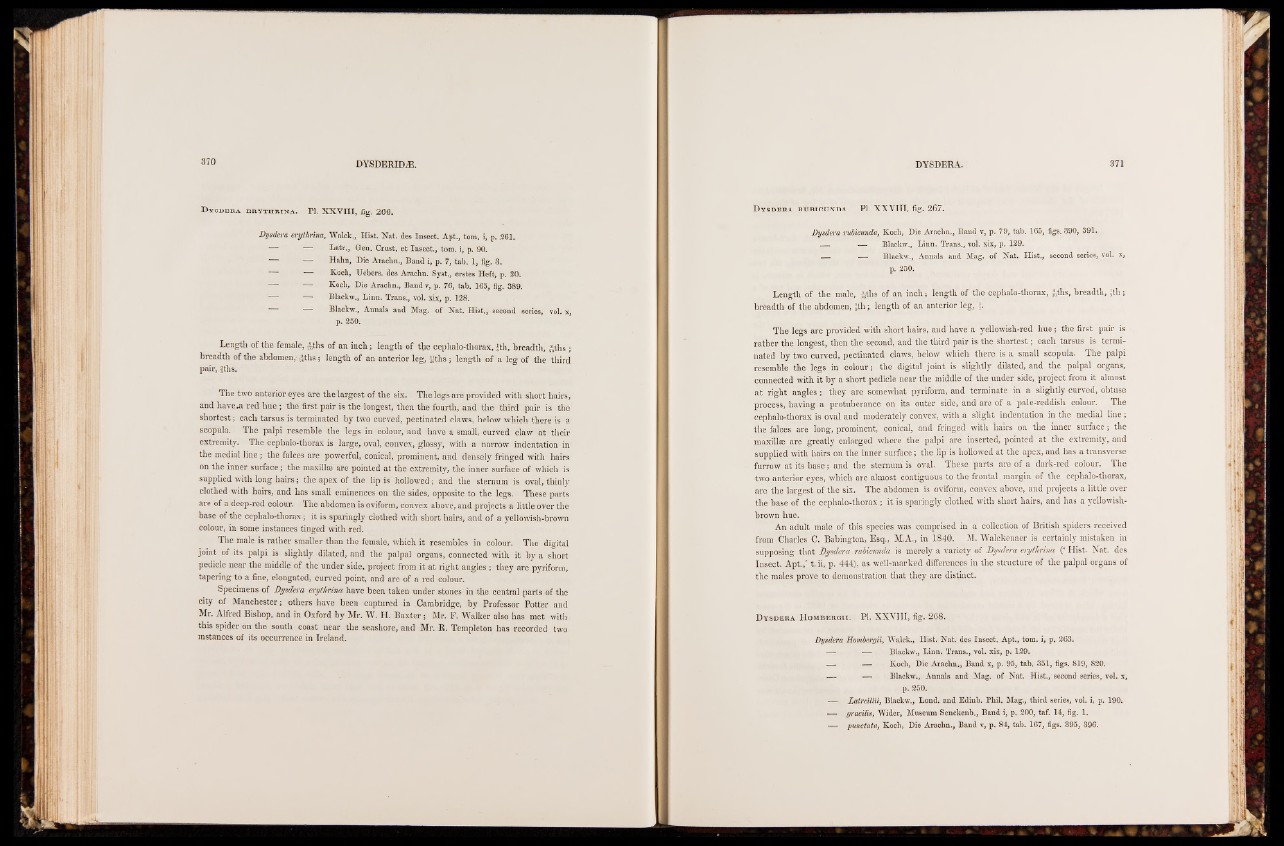
Dysdera erythrina. PI. XXVIII, fig. 2C6.
Dysdera erythrina, Walck., Hist. Nat. des Insect. Apt., tom. i, p. 261.
—■ ' — Latr., Gen. Crust, et Insect., tom. i, p. 90.
— — Hahn, Die Arachn., Band i, p. 7, tab. 1, fig. 3.
— . ^ Koch, Uebers. des Arachn. Syst., erstes Heft, p. 20.
— Koch, Die Arachn., Bandv, p. 76, tab. 165, fig. 389.
"i-- * — Blackw., Linn. Trans., vol. xix, p. 128.
— — Blackw., Annals and Mag. of Nat. Hist.,' second series, vol. x,
p. 250.
Length of the female, 4 ths of an inch; length of t^ie cephalo-thorax, }th, breadth, 4 ths ;
breadth of the abdomen, 4 th s . length of an anterior leg, ^ th s; length of a leg of the third
pair, §ths.
The two anterior eyes are the largest of the six. The legs are provided with short hairs,
and have.a red hue ; the first pair is the longest, then the fourth, and the third pair is the
shortest; each tarsus is terminated by two curved, pectinated claws, below which there is a
scopula. The palpi resemble the legs in colour, and have a small, curved claw at their
extremity. The cephalo-thorax is large, oval, convex, glossy, with a narrow indentation in
the medial lin e ; the falces are powerful, conical, prominent, and densely fringed with hairs
on the inner surface; the maxillae are pointed at the extremity, the inner surface of which is
supplied with long hairs; the apex of the lip is hollowed; and the sternum is oval, thinly
clothed with hairs, and has small eminences on the sides, opposite to the legs. These parts
are of a deep-red colour. The abdomen is oviform, convex above, and projects a little over the
base of the cephalo-thorax; it is sparingly clothed with short hairs, and of a yellowish-brown
colour, in some instances tinged with red.
The male is rather smaller than the female, which it resembles in colour. The digital
joint of its palpi is slightly dilated, and the palpal organs, connected with it by a short
pedicle near the middle of the under side, project from it at right angles ; they are pyriform,
tapering to a fine, elongated, curved point, and are of a red colour.
Specimens of Dysdera erythrina have been taken under stones in the central parts of the
city of Manchester; others have been captured in Cambridge, by Professor Potter and
Mr. Alfred Bishop, and in Oxford by Mr. W. H. Baxter; Mr. F. Walker also has met with*
this spider on the south coast near the seashore, and Mr. R. Templeton has recorded two
instances of its occurrence in Ireland.
Dysdera rubicunda. PI. XXVIII, fig. 267.
Dysdera rubicunda, Koch, Die Arachn., Band v, p. 79, tab. 165, figs. 390, 391.
— — Blackw., Linn. Trans., vol. xix, p. 129.
— — Blackw., Annals and Mag. of Nat. Hist., second series, vol. x,
p. 250.
Length of the male, ^ths of an inch; length of the cephalo-thorax, 4ths, breadth, £th;
breadth of the abdomen, ^th; length of an anterior leg,
The legs are provided with short hairs, and have a yellowish-red h u e ; the first pair is
rather the longest, then the second, and the third pair is the shortest; each tarsus is terminated
by two curved, pectinated claws, below which there is a small scopula. The palpi
resemble the legs in colour; the digital joint is slightly dilated, and the palpal organs,
connected with it by a short pedicle near the middle of the under side, project from it almost
at right angles; they are somewhat pyriform, and terminate in a slightly curved, obtuse
process, having a protuberance on its outer side, and are of a pale-reddish colour. The
cephalo-thorax is.oval and moderately convex, with a slight indentation in the medial line;
the falces are long, prominent, conical, and fringed with hairs on the inner surface; the
maxillm are greatly enlarged where the palpi are inserted, pointed at the extremity, and
supplied with hairs on the inner surface; the lip is hollowed at the apex, and has a transverse
furrow at its base; and the sternum is oval. These parts are of a dark-red colour. The
two anterior eyes, which are almost contiguous to the frontal margin of the cephalo-thorax,
are the largest of the six. The abdomen is oviform, convex above, and projects a little over
the base of the cephalo-thorax; it is sparingly clothed with short hairs, and has a yellowish-
brown hue.
An adult male of this species was comprised in a collection of British spiders received
from Charles C. Babington, Esq., M.A., in 1840. M. Walckenaer is certainly mistaken in
supposing that Dysdera rubicunda is merely a variety of Dysdera erythrina (‘ Hist. Nat. des
Insect. Apt.,’ t. ii, p. 444), as well-marked differences in the structure of the palpal organs of
the males prove to demonstration that they are distinct.
Dysdera Hombergii. PI. XXVIII, fig. 268.
Dysdera Hombergii, Walck., Hist. Nat. des Insect. Apt., tom. i, p. 263.
— — Blackw., Linn. Trans., vol. xix, p. 129.
— — Koch, Die Arachn., Band x, p. 95, tab. 351, figs. 819, 820.
— — Blackw., Annals and Mag. of Nat. Hist., second series, vol. x,
p. 250.
Laireilln, Blackw., Lond. and Edinb. Phil. Mag., third senes, vol. i, p. 190.
— gracilis, Wider, Museum Senckenb., Band i, p. 200, taf. 14, fig. 1.
— punctata, Koch, Die Arachn., Band v, p. 84, tab. 167, figs. 395, 396.